Vomiting occurs in dogs as a response to digestive indiscretions, food sensitivities or allergies, infections, digestive tract blockage, and other underlying conditions.
Vomiting is the ejection of the contents of the stomach and upper intestines, while regurgitation is the expulsion of food and other contents from the esophagus.
Vomiting frequently occurs in conjunction with diarrhea, gas, and bloating in dogs and can lead to dehydration, electrolyte imbalances, and occasionally death.
Vomiting in dogs may be treated with short fasts, bland diets, fluid therapy, prescription medications, and in serious cases, surgical intervention.
Vomiting is a messy symptom of gastrointestinal distress in dogs that many dog guardians face and that may cause serious complications for your pup. That's why it's important to seek veterinary attention for your furry family member as quickly as possible when you are unsure why your dog is throwing up.
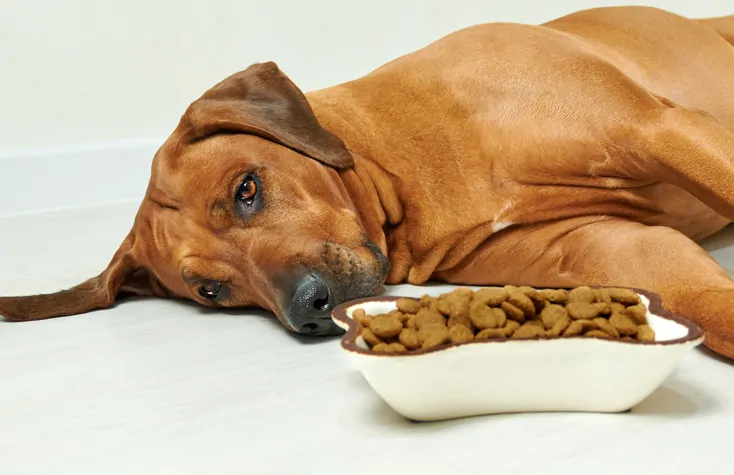
Some illnesses that resemble vomiting could be caused by a different condition. Active retching or heaving along with throwing up food or bile are indicators that vomiting is your dog's issue. Liquids, mucus, or white or yellow foam may also be visible.
On the other hand, regurgitation is more likely if your dog is bringing up food they've recently eaten, particularly if it's undigested food and there isn't any heaving, retching, or gagging involved, instead the food seems to pop out unexpectedly.
Regurgitation is the expulsion of the contents of the esophagus, whereas vomiting is the ejection of the contents of the stomach and upper intestine. A violent cough can also resemble vomiting in both appearance and sound; some canine coughs even produce foam.
Vomiting, regurgitation, and coughing all have unique causes and hence require unique treatments, though the distinctions can be slight. Any observations you make will therefore aid your veterinarian in making an accurate diagnosis.
There are multitudes of diverse reasons why your dog may be vomiting. Some of the most common causes of vomiting in dogs include:
Fortunately, most occurrences of vomiting in healthy dogs may be quickly and effectively treated. Sometimes, however, your dog's vomiting may be a symptom of a dangerous or even fatal underlying condition. If your pet develops any of these signs, you should take them to the vet right away:
Check your dog for dehydration by looking for dry or pale gums and "tenting" on the skin. You can check for tenting by pulling up on the skin between your dog's shoulder blades and observing how it settles back down. Your pup is likely dehydrated if it continues to stand up like a tent.
The underlying cause of vomiting in your dog will determine the course of treatment. To rule out a foreign body, an underlying ailment, or other problem, your veterinarian may want laboratory tests or X-rays in addition to a physical examination.
These diagnostics assist your vet in identifying the source problem more, avoiding harmful complications, and providing more effective, and often, less expensive treatment.
Here are a few typical treatments for the majority of conditions that cause vomiting in dogs:
Do not administer any human drugs or over-the-counter medications to dogs without first seeing your veterinarian.
You can reduce your dog's risk of developing conditions that cause vomiting by:
These suggestions may be helpful in preventing other health issues as well. If your pet vomits three or more times in an eight-hour period or has other concerning symptoms, don't hesitate to get vet help right away, as some conditions which cause vomiting in dogs can be life-threatening and time-sensitive.
When you bring home a new kitten, you should prepare a small, comfy area from which to explore their new home, schedule a vet visit within two weeks, socialize your kitten, feed them high-quality food, engage them in daily play, and spay or neuter your kitten around six months old.
Your kitten's vital signs will be checked, a complete examination will be performed, and your veterinarian will recommend vaccines, wormers, and other aides, such as microchips, that suit your kitten's lifestyle.
Kittens are usually eligible to be spayed or neutered at about six months of age (the timing is critical to prevent mammary tumors in females and spraying in males).
Kittens are comparatively low-maintence, polite, graceful, independent, and clean housemates. But did you know they also have healing powers?
Your kitten possesses a very particular set of health benefits that you don't find in other animals. The vibrations from your kitten's purr, for example, assist with bone healing and migraines as well as decreasing blood pressure, reducing osteoporosis, and increasing your chances of surviving a heart attack. Petting your kitten has also been shown to release oxytocin, "the love hormone."
They can also teach you a lot about healthy relationships because cats offer unconditional love, have respect for personal space, and inspire their owners to be more patient and caring towards others. Kittens aren't very needy but they do require care to enjoy a long and healthy life. Here we will provide the particulars of raising a kitten.

Kitten-proofing should be done before your new kitty actually arrives at your home. Some plants are toxic to cats and should be positioned out of the reach of kittens because they tend to consume them. But, the majority of plants irritate their stomach when consumed.
Similar to childproofing a house, breakables should be out of your kitten's reach, garbage can lids should be covered, blind cords should be wrapped, and window screens should be properly fastened. Additionally, since some kittens genuinely enjoy eating certain materials, store thread, plastic, elastic bands, and paper, away from your kitten's reach. Shrewd kitties often figure out how to access cupboards and cabinets, in which case, baby locks may be utilized to prevent them.
Your kitten will feel more at ease if you keep them in a smaller section of the house while they get used to their new surroundings. Kittens start to explore their new territory as they become more comfortable. Feliway, a natural cat pheromone that comes in a spray or diffusible oil, calms kittens during this transition.
Every kitten needs a thorough, head-to-tail, checkup a couple of weeks after coming home to ensure that everything is in good order. Your kitten's vital signs will be checked and a complete examination will be performed as well as any lab tests your vet considers necessary. Your veterinarian will also ask questions about your kitten's lifestyle to inform their recommendations as to which vaccines, wormers, and other aides, such as microchips, will be helpful in your kitty's case. Common kitten viruses that require vaccinations include:
Vaccine reactions in kittens are rarely severe and often clear on their own. Possible side effects include pain and swelling at the injection site, lethargy, and mild fever. If your kitten develops facial swelling, hives, diarrhea, or difficulty breathing, return to your veterinary office immediately. Your kitty may also be tested for worms, but will likely be given deworming medications regardless of the result since parasites are so common in kittens. Your kitten should be rechecked for worms at six months of age.
It's vital to your kitten's health that they be fed according to their "life stage." Kittens should be fed high-quality kitten food until they are one year old. High-quality cat food will list a protein source as its first ingredient.
Your vet can determine your cat's body condition score (BCS) to help guide your kitten's diet plan. Canned food is considered best for your kitten and a mix of dry and canned food is best for their teeth. Food can be left out for a kitten's first six months of life, but after that point, most cats need to start using some type of portion control to prevent obesity, which is a major issue for many cats.
Kittens will be vulnerable to dehydration throughout their lives, so it's good to scatter water bowls around the house to encourage them to drink.
It's crucial to get your cat used to being handled and held by others during the first few months. Offer a kitten cuddle to friends and family to help socialize your kitty.
Your vet will demonstrate how to handle your kitten's feet, trim their nails, clean their ears, brush their coat, and properly brush their teeth on their initial visit to the veterinarian. Treats can be given as an incentive to encourage positive behavior.
Additionally, if your kitten carrier is kept outside, your kitty may become accustomed to its presence and feel at ease playing or resting in it. The chances of getting your kitten inside a carrier without a fuss increase if your kitty doesn't exclusively associate their carrier with trips to the veterinarian.
Play is part of your kitten's everyday routine. Don't allow your kitten to play with any of your body parts, however how harmless it might seem. If your kitty tries to bite your fingers or bite your toes, you should ignore them and divert their attention with a suitable toy. Kittens become excited by any response, even one that is critical, and will be motivated to keep trying.
Offer plenty of horizontal and vertical scratching posts and a variety of toys to keep your kitten amused. Kitties who play vigorously are likely to sleep a lot in between play sessions. Play with them earlier in the evening to tire them out before bedtime and prevent their nightly shenanigans from conflicting with your overnight sleep.
Spaying or neutering reduces the number of stray cats that have to be euthanized in your community. Kittens are usually eligible for the procedure at about six months of age (the timing is critical to prevent mammary tumors in females and spraying in males). Prior to spaying/neutering surgery, baseline/pre-surgical blood is typically taken to confirm that your kitten is a safe candidate for anesthesia and to give a baseline against which future results can be compared. This also double-checks your kitten's virus status. Their electrolytes, blood sugar, white and red blood cell counts, and kidneys will all be examined before surgery. Your vet will provide detailed after-care instructions.
Worms are primarily transmitted to dogs through their mother's placenta, contaminated soil and fleas.
The most common types of worms in dogs are hookworms, roundworms, whipworms, heartworms, and tapeworms.
Common symptoms of worms in dogs include weight loss, fatigue, gastrointestinal distress, distended stomach, and visible worms in feces.
Intestinal worms are treated with deworming medications while heartworms are treated with a series of injections.
Keeping your canine worm-free is a common challenge that most dog owners face. Worms cause serious health problems for dogs if left untreated so responsible dog owners take special care to understand the dangers, symptoms, and available treatments for canine worms.

Worm larvae and eggs are very difficult to see, and by the time you see adult worms, they are already a problem. Therefore, it's important to know where worms come from to begin with:
Dogs are most commonly infected with hookworms, roundworms, whipworms, heartworms, and tapeworms. Hookworms fasten themselves to dogs' small intestines, suck their blood, and cause anemia, which is potentially fatal to puppies. Small roundworm larvae are present in a large percentage of newborn puppies but can grow to be several inches long and can cause potentially-fatal intestinal blockages. Whipworms cause few symptoms and live in dogs' small intestines, where they produce eggs that can survive in the soil for years. Heartworms are foot-long worms that dwell in the heart, lungs, and arteries of infected dogs and can lead to severe lung disease, heart failure, and harm to other organs. Tapeworms are flat, segmented worms that transfer to dogs through ingested fleas, cause mild symptoms, and can grow up to two feet in length.
The best way to know if your dog has worms is to have your veterinarian conduct a fecal exam. You may, but, keep an eye out for certain symptoms and indicators at home that could indicate your dog has worms.
While tapeworms are visible in your dog's stool, other intestinal worms usually have to be identified through microscopic inspection of a stool sample to look for eggs. It is advisable to give your vet a stool sample when your dog is getting his annual checkup, even if there are no symptoms. A blood test can usually identify heartworms, but, a radiograph, ultrasound, or echocardiograph may be necessary in rare circumstances. Many dogs with heartworm disease in its early stages exhibit few or no symptoms, but the earlier treatment begins, the higher the success rate. Therefore, it is a good idea to test heartworms on a yearly basis.
Deworming medications come in a variety of forms that can prevent and treat intestinal parasites. These can be given via injection, pill, or topical application. When using pet store items, make sure you are giving the right dosage for your dog's body weight and that you are aware of the types of worms that each treatment is effective against. A single treatment of dewormer may also be insufficient to eradicate all worms from your dog's body. Fresh larvae can enter the intestine following deworming so more treatment may be required to eradicate the illness. Additionally, routine deworming is not always enough to stop mothers from spreading worms to their offspring, as a result, special medications may be needed. Dogs that are infected with heartworms need a special series of injections because intestinal dewormers are not effective for heartworms.
The best practice for most dog owners is to administer a worm preventative to your pet year-round. In fact, a dewormer for intestinal parasites is contained in many heartworm prevention treatments. Based on the worms present in your area of the country and the life style your dog leads, your veterinarian will advise you on the best course of action. There are also several actions you can do in addition to drugs to avoid worm infestations:
Preventing worms in dogs also protects dog owners. When worms are present in your environment, they are easier to catch than you may realize. Dog owners can be infected with worms by handling puppies and kittens, coming in contact with contaminated soil, cleaning up pet waste, or ingesting infected fleas when sleeping or playing with their dogs. You can reduce your risk of catching worms from your dog by wearing gloves, using a bag to collect feces, and keeping your lawn and garden clear of dog waste.
A mass is a lump that occurs directly under, inside, or on your pets skin caused by abnormal cell growth, immune reactions, hormonal changes, or a cyst.
If you find a mass on your pet, take a picture of it, measure it, watch it for changes, and call your vet.
Masses are diagnosed through fine needle aspiration but further diagnostic test may also be performed including surgical biopsy, x-ray, ultrasound, and MRI.
Your pet will be put under anesthesia, the mass will be removed, sutures are used to close the incision, and the mass may be sent to the lab for further testing.
Your pet should recover in a comfortable spot, possibly fitted with an Elizabethan collar, and be prevented from jumping, climbing, and intense activity.
Aging pets often get masses or growths under their skin and they are usually nothing to worry about. Still, it's an unpleasant surprise to find one when you are stroking your pet's fur. A mass is a lump that occurs under, inside, or on top of your pet's skin, and can be caused by an abnormal growth of cells, immune reactions, hormonal changes, or a cyst. Some common masses that occur on pets include benign tumors such as lipomas, skin tags, or cysts. Less often, the mass is malignant such as with mammary tumors, squamous cell carcinomas, osteosarcomas, mast cell tumors, and lymphomas.

Even though most lumps you find on your pet will not need treatment unless they become irritated or inflamed, even the smallest chance of cancer is too much to ignore. So, it's important to investigate the cause of any mass you find on your pet. Here are some steps you should take when you notice a growth in your pet.
At your pet's appointment, your veterinarian will determine what the mass is made of using a type of biopsy called fine needle aspiration. The process requires that a needle be inserted into your pet's mass so that a cell sample may be taken from it. Your veterinarian can determine whether it is cancerous by looking at it under a microscope.
If a malignant tumor is discovered, your vet may advise "staging" your pet, which could entail a surgical biopsy, x-rays, ultrasound, or MRI to see if cancer has spread to other parts of their body before surgical removal. If cancer has not spread from the mass, your vet will want to remove it as quickly as possible before the mass has a chance to spread. If cancer has spread, simply removing the mass wouldn't cure cancer, so other treatment options such as chemotherapy and radiation, or even experimental treatments and alternative therapies may be explored in addition to mass removal.
If your pet only needs mass removal, that is very good news. It means that, with surgery, aftercare, and close observation, your pet has an excellent chance at a happy outcome.
Your pet will be anesthetized for their mass removal surgery. While your pet is under anesthesia, their oxygen levels, pulse, blood pressure, respiration, heart rate, and body temperature will be closely monitored.
The tumorous mass may be removed by electrocautery, a surgical procedure that uses an electric current to heat a metal wire electrode that destroys abnormal tissue and can be used to control bleeding during surgery. Once the tumorous tissue is removed, the incision will be closed with sutures that will either be absorbed by your pet's body as they heal or have to be removed by your vet at a later date.
Veterinarians often recommend that the mass be submitted to a diagnostic laboratory after it is removed for further testing that can identify the exact type of cancer that caused the mass and determine the margins of mass removal, which indicate whether the mass was completely removed during surgery. Your vet may make further treatment recommendations based on the laboratory results.
It's typical for your pet to feel a little lethargic for a day or two after surgery. Call your veterinarian if your dog or cat appears to be in discomfort. They might be able to recommend a medication to lessen the pain.
In order to ensure that your pet heals and recovers as quickly as possible after the mass removal procedure, it is imperative that you heed all your veterinarian's aftercare instructions. Giving your recovering pet a place to relax, using an Elizabethan collar if necessary, and preventing them from climbing, jumping, and doing intense activities following the surgery will help aid their recovery. Some issues to watch for post-surgery include:
If you notice any of these issues or have any other concerns about how your pet is recovering, seek further advice from your veterinarian.
Dogs that exhibit changes in energy levels and sleep patterns, gastrointestinal issues, mobility problems, gum changes, fever, itching and gnawing, and behavior changes may be sick.
Some symptoms resolve on their own in a couple of days, monitor your dog's condition for signs of acute distress such as extreme lethargy, fever, and difficulty breathing that require emergency veterinary intervention.
Give your dog all prescribed medications on time, take care of wounds and dressings, feed them vet-recommended food, and provide a comfortable space for them to rest and recover.
Dogs can't express to their owners that they are sick but they wouldn't even if they could. Wild animals are hard-wired to hide pain, injury, and illness to protect themselves from predators when they are in a weakened state. Although they have been domesticated for thousands of years, dogs still have this behavioral trait. It makes it difficult to determine if your dog is in pain, especially since canines are so loyal and loving that they have been known to jump up and greet their humans, even with fractured bones and other injuries.
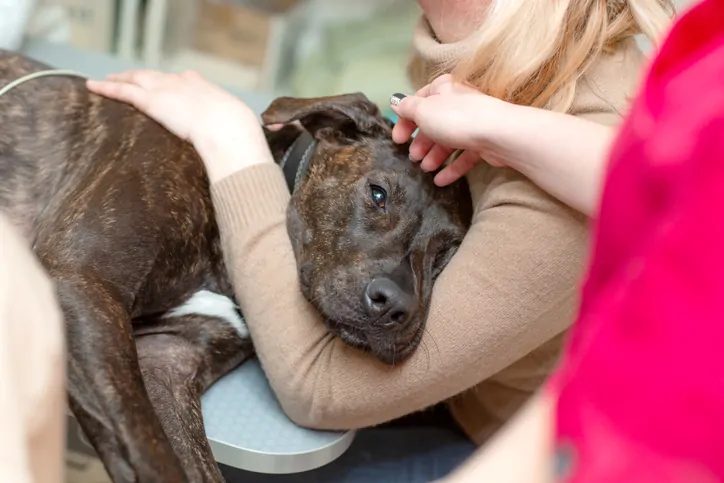
Dogs are creatures of habit that often develop observable routines which can give clues related to their well-being. Take notice of when your dog is active or at rest and be watchful for changes in those patterns. If your dog appears lethargic, it could say a viral, parasitic, or bacterial infection as well as anemia, injury, poisoning, or reaction to the medication. If your dog appears to have trouble getting a comfortable sleep, seems restless during normal sleep times, or gets up more often in the night, it could be a sign of pain and discomfort. Also, sleeping more than usual could mean your dog has a serious medical issue such as hypothyroidism, kidney disease, diabetes, arthritis, or heart issues.
One of the most obvious and disagreeable signs of sickness in your dog is the development of a gastrointestinal issue. Gastrointestinal disturbances come in a variety of forms including:
Dogs with joint issues, hip dysplasia, arthritis, fractured bone, infections, or other ailments may have trouble walking, rising, and jumping. If your dog is not taking stairs or jumping onto the bed or couch, as usual, this could be a sign that they are experiencing joint pain or have an existing injury. Dogs that show reluctance or stiffness when getting up may be exhibiting early signs of osteoarthritis. Lower activity levels and disinterest in play might also signal mobility issues.
Dog's gums are pink and moist. Pale gums can indicate anemia or shock. Shock is a serious condition caused by trauma, blood loss, heatstroke, burns, infections, allergic reactions, poisoning, and other acute conditions. When dogs are in shock, their organs don't get enough blood or oxygen which can lead to permanent organ damage or even death. Other gum changes to watch out for include:
Normal body temperature for dogs ranges from 101-102.5 degrees. Elevated temperature in dogs is related to a variety of conditions from bacterial, viral, and fungal infections to infected wounds, immune disorders, or even cancer. When taking your dog's temperature, lubricate the thermometer with something like petroleum gel or baby oil beforehand. Then, carefully place the thermometer about an inch inside your dog's anus and watch for the readings. Typically, the thermometers used for this purpose register within 60 seconds.
Itching, gnawing, and biting parts of their body are also signs that sick dogs may exhibit. These behaviors are associated with flea infestations, canine allergies, and certain infections, and are often accompanied by redness, hair loss, swelling, abnormal odor, and discharge.
Sudden behavioral changes in dogs, such as aggression, biting, or over-protectiveness of certain body parts, might also raise red flags. Aggression and biting, for instance, might be signs of canine rabies. Dogs may avoid contact or snap at you if they are in pain. If your dog starts acting, they may be sick or injured.
The best course of action for addressing canine illness or injury is dependent on the type and severity of the issue.
Many pet owners experience feelings of helplessness and anxiety when their four-legged family member becomes sick, but the truth is that no one is more capable of helping your dog feel better than you. To that end, you should always administer medication at the proper times and treat wounds and dressings by your vet's instructions to speed up your dog's recovery from illness or injury. Most importantly, show your dog a lot of affection, reassure them that you love them, and encourage them to eat vet-recommended food. Also, make sure your dog has a cozy place to rest and recover in peace. As your dog starts to get better, you can re-introduce them to their normal routines and activities with permission from your vet.
To begin raising your puppy, you should schedule their first vet visit, puppy-proof your house, feed them high-quality food, train and socialize your puppy, and spay or neuter after they mature.
Your puppy will be examined, vaccinated, and tested for worms. Your vet will also instruct you in the care requirements for your puppy based upon their breed and condition.
Once your pup is 8 weeks old, you can begin teaching simple commands in 5-10 minute training sessions that include lots of positive reinforcement.
Puppies. They're so cute that simply saying "puppies" is enough to make most dog lovers smile. And they're irresistible. The instant you pick up a puppy, you feel compelled to take it home. Next thing you know, there's a barking, shedding, chewing bundle of fluff roaming all over your place. Whatever strange powers puppies may have over us, the enchantment begins to fade after you get them home, and the reality of raising a puppy sinks in.
You don't have to fall out of love with your puppy when the spell breaks, but, if you have the right tricks up your sleeve. Here, we will reveal some puppy-raising tips that work like magic.
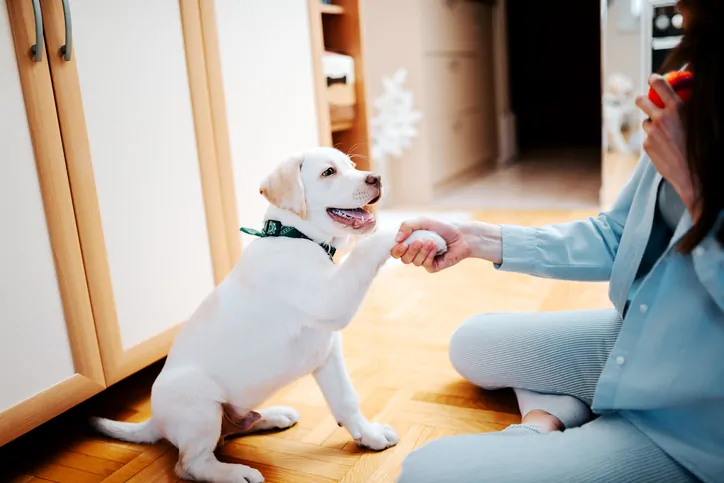
The last thing you need is for your puppy to get sick soon after you bring them home. Puppies have underdeveloped immune systems and are vulnerable to illness and injury. While puppies are nursing, they receive protection from germs through antibodies in their mother's milk. Around six weeks of age, those antibodies start to wear off, and your puppy will need to be vaccinated to remain protected.
Additionally, puppies adopted from a shelter may be exposed to other dogs that carry viruses which could prove fatal to puppies. At your puppy's first veterinarian visit, ideally between 6 and 8 weeks old, they will be vaccinated against viruses that are common in shelters including:
In addition to vaccinations, your puppy's first vet visit will include a thorough examination. Your vet may also take a stool sample to check for intestinal parasites. At the first veterinary visit, you will receive information about your pup's breed-specific care requirements including exercise needs, dental care, reproductive health, nutrition, and vaccination schedule.
Your puppy will need to return to the veterinarian a few weeks later for additional vaccines that protect against the following:
Veterinarians can start heartworm prevention at eight weeks of age. Heartworm prevention is only effective on late-stage larvae so, most heart wormers must be given monthly. If you miss a dose or are more than two weeks late, your pup will need a blood test to check for adult heartworms. Heartworm disease can cause damage to your puppy's heart and lungs months before it can be detected by a blood test, causing long-lasting, life-altering effects. Most heartworm prevention also protects against intestinal worms, and some may even include flea prevention.
A puppy-proofed home may sound like a fairy story but it can be achieved with some strategic adjustments around the house. Start with setting your home up for puppy potty training. If you are crate training your pup, ready it before you bring them home with comfy blankets and a treat or toy to tempt them in. Introduce your pup to its crate by leaving the door open for them to explore on their own. Make sure your pup has room in its crate to stand up, lie down, and turn around. Other ways to puppy-proof your home include:
The best way to keep your puppy out of mischief is to make sure they are getting plenty of exercise and stimulation. If your pup is running around the house like a wild animal, it's a good time to take 10-15 minutes to play catch, go for a walk, or romp around in the yard with your furball.
At four to six weeks old, introduce your puppy to solid food by combining kibble with a milk replacer to make a gruel. This reduces gastrointestinal discomfort and helps them adjust to solid food. By eight weeks old your puppy should be ready for dry food.
The best puppy foods feature ingredients that are healthy sources of protein, calcium, and calories. Ensure your puppies dog food has GRAIN – this is vital for a healthy heart. Try to stay away from items that include high quantities of corn or meat by-products; meat should always be the first ingredient. Three to four feedings each day are best for puppies. Smaller meals digest more and balance puppy energy levels.
You should transition your puppy to adult food as they approach maturity because puppy food is particularly high in calories and nutritional supplements. Extended use of puppy food may cause obesity and orthopedic issues.
The most beneficial training you can give your puppy is socialization. A puppy must be socialized to enjoy interactions and feel at ease with other animals, people, locations, and activities.
Socializing should start when a puppy is between 3 and 14 weeks old. Begin socializing your puppy by encouraging friends and family to hold and pet your puppy. Once your pup is 16 weeks old and fully vaccinated, visiting the dog park can help them learn to get along with their peers. Taking your puppy to the groomers early and often will teach them to tolerate being handled.
You can start teaching your puppy simple commands such as come, sit, down, and stay at around 8 weeks of age in training sessions that last no longer than 5 to 10 minutes and always end on a positive note.
Spaying or neutering your pooch reduces the number of stray dogs that end up being euthanized. Small breed dogs are mature enough to spay or neuter at around 6 months of age, while larger breeds may not be mature enough until 16 to 18 months old. Nevertheless, scheduling your pup's spay or neuter as soon as they are mature enough makes the surgery easier for your veterinarian and helps your puppy recover faster.
Ticks spread a host of serious, incurable diseases to cats, dogs, and people. Therefore, tick control and prevention are as important to your family's health as it is to your pet's. Here we will look at why tick control is important for your cat, your dog, and your family as well as some ways you can prevent these pests from causing you and your pet serious, irreparable harm.
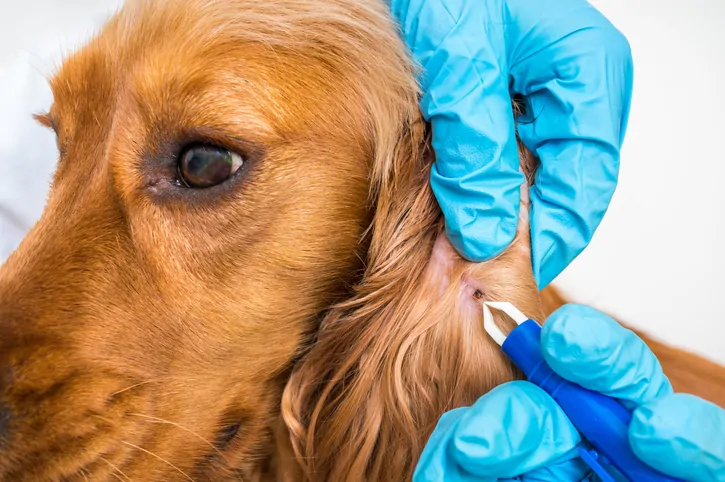
Ticks are a parasitic form of arachnid, like spiders, scorpions, and mites, that feed on both human and animal blood. They rely on their hosts to bring them onto your land or around your house because they can't fly or jump to go around. Ticks are frequently carried by wild animals when they occur in your area. Deer, horses, rats, and other types of wild animals can all serve as tick hosts. Cats and dogs typically act as carrier hosts for parasites once they are on your property, which allows the parasites to enter your home.
Ticks exist in a variety of temperature zones and are found all across the country. However, they seem to prefer the damp, shady woodlands of the Northeastern US the most. A US News report found that Pennslyvania had the highest incidence of tick-borne illness in the United States, followed by many of its east coast neighbors. Minnesota and Wisconsin in the northern Midwest also made the list.
Ticks transfer disease-causing viruses, bacteria, and microscopic parasites to pets and humans through their saliva which enters their host's bloodstream when the tick bites. The most common diseases spread by ticks include:
Many tick-borne diseases have common symptoms that can include body aches, joint pain, headache, fever, rash, fatigue, stiff neck, swollen lymph nodes, and facial paralysis.
Ticks are relatively easy to locate once they've settled in for a bite because, if unbothered, they will feed in the same spot for anywhere from 3 to 10 days. Ticks typically seek out the warm, moist cracks or crevices of their host for comfort and less chance of detection. So if you're checking your dog or cat for ticks make sure to look deep within your pet's coat, inside and around their ears, around their neck, and between their legs and toes.
To get rid of ticks on your pet and prevent them from getting new ones, most pet owners one or more of the following:
Some medications used to treat ticks in dogs are harmful to cats so make sure you purchase tick treatments that are formulated specifically for your pet. Tick control medications are often found in combination with flea control and prevention medications so be sure to check the label to see if the product you choose protects your pet from more than one kind of pest. To identify the best tick prevention for your cat or dog, consult your veterinarian.
The most obvious signs of digestive issues in dogs are vomiting, diarrhea, bloating, and loss of appetite.
Digestive issues in dogs may be caused by many things including foreign objects, food intolerance, inflammatory conditions, parasites and cancer.
To diagnose your dog's digestive issues, your vet will get a thorough history, perform a detailed examination, and order some laboratory, imaging, or exploratory tests.
Treatment for digestive issues in dogs targets the underlying issues in combination with supportive care.
Digestive issues are the most common reasons dogs end up at the vet's office. Digestive issues in dogs vary in severity, frequency, and cause.
Your dog must have a healthy digestive system to use food nutrients to create new tissue, repair existing tissues, and produce energy. It's critical to detect the symptoms of GI issues and speak with your veterinarian because they can cause dehydration, acid-base and electrolyte imbalances, and malnutrition.
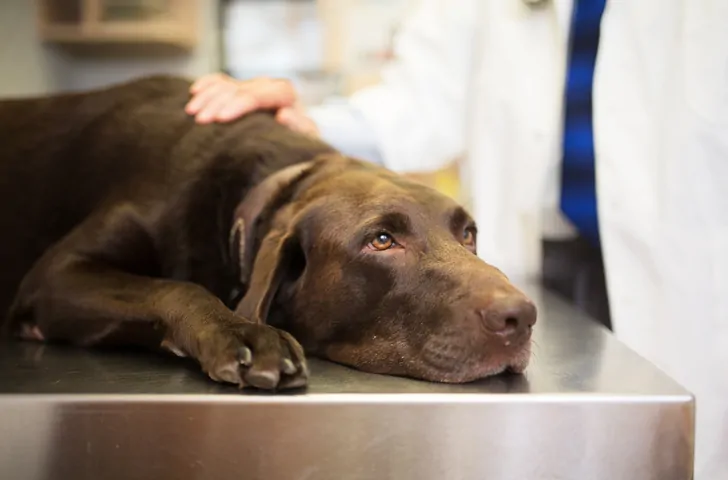
Gastrointestinal (GI) disorders and diseases that affect a dog's stomach and intestines cause pain and other issues for your beloved pet. A digestive disorder is any condition that affects how food is absorbed, digested, or moves through the digestive tract. The most common signs of digestive issues in dogs are:
Digestive issues can cause a lot of pain that your dog can't express. If your dog has a hard time getting comfortable, is sitting in a tensed or hunched posture, or bows frequently with paws and chest on the floor and hindquarters raised in the air, they may be experiencing digestive issues.
Take your dog to the vet if your dog's digestive issues last longer than 48-72 hours. Emergency vet care may be required if your pet's condition deteriorates rapidly as can happen with serious digestive illness. Blood in your dog's vomit or diarrhea, lethargy, fever, obvious signs of pain, and bloating or distention of your dog's belly are signs that indicate your dog needs urgent care.
There are literally hundreds of potential causes for digestive issues in dogs. Digestive issues can present suddenly or develop gradually. Some of the most common causes of digestive issues in dogs include:
Your veterinarian will thoroughly investigate the cause of your dog's digestive issues. This includes asking questions about anything your dog may have been exposed to and requesting a detailed description of their symptoms to get an accurate history of your dog's digestive issues.
Your vet will also perform a physical examination that entails palpating the belly for indications of anomalies, as well as assessing your dog's temperature, pulse, heart rate, lungs, level of hydration, gland/lymph node activity, and other things. This helps to plan which diagnostic tests to use and provides important information about the health of a dog.
Laboratory testing reveals information about what is happening inside your dog's body. Based on the information you provide for your dog's health history and the observations of your vet during the physical exam, your vet may order diagnostic procedures such as:
Except in urgent care cases, your vet will likely order the most basic tests first and only move towards more invasive testing procedures if your dog is not responding well to initial treatment.
Treatment for digestive issues in dogs targets the underlying issues involved. A dog with intestinal parasites, for instance, would be treated with a dewormer, whereas a dog with an obstruction would need surgery. To put it another way, the type of treatment depends on what's causing the intestinal issue.
Supportive care is required as well. Anything that is done to reduce symptoms and complications, such as dehydration from vomiting, while making your dog feel more comfortable is considered supportive care. Supportive care treatments include medications for nausea, gas, and diarrhea as well as probiotics, plain foods, and fluid therapy.
If your pup is otherwise healthy and is keeping food and water down but has started showing mild signs of digestive distress, it is usually fine to observe them for a couple of days and try a few simple home remedies including:
This method is not safe for puppies, older dogs, and small breeds because they cannot tolerate calorie restriction.
Most serious conditions that cause digestive issues in dogs can not be prevented. However, the most common causes of GI distress in dogs can be prevented by following these tips:
Dogs experience digestive problems, and most will experience at least a few episodes of an upset stomach during the course of their lifetime. You can keep your furry friend as healthy as possible by taking precautions and getting your dog to a veterinarian right away if they aren't feeling well.
Stinky breath in dogs may be caused by periodontal disease that can result in tooth loss, abscesses, and systemic infections.
Yes. Neglecting your dog's dental care may cause serious health issues that can take years off their life.
Proper dental care for dogs includes regular examinations and frequent at-home dental hygiene, as well as dental cleanings by your vet as needed.
Brushing your dog's teeth with a vet-approved toothpaste at least two or three times a week is the best way to care for your dog's teeth at home.
If your dog resists brushing, you can give them treats, chews, and food additives that help scrape tarter off their teeth as they chew and promote healthy bacteria.
Canine dental disease caused by poor dental hygiene is a common problem faced by the majority of dog owners. Most dogs begin to exhibit symptoms of canine periodontal disease by the age of three. Dog guardians ignore their pet's foul breath because they believe that it's natural for it to be stinky. But, bad breath in dogs is usually the earliest warning sign of periodontal disease. Untreated dental disease can result in tooth loss, excruciating abscesses, and systemic infections that affect every part of your dog's body. Periodontal disease also increases the risk of canine heart disease and can cause permanent jaw damage.
Periodontal disease in dogs is irreversible and can take up to two years off your dog's life. However, there are things that you can do to prevent periodontal disease or even help slow disease progression when combined with veterinary treatment.
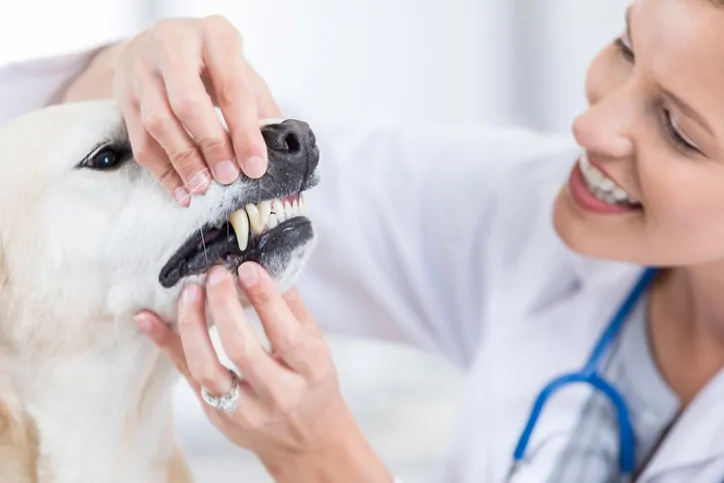
Brushing your dog's teeth is a great way to stop plaque from accumulating and prevent periodontal disease. Although it's best to brush frequently, you don't have to clean your dog's teeth every day. Your dog may resist having their teeth brushed at first, but, with patience and consistency, they can be trained to accept the process without much fuss.
Using toothpaste flavored to appeal to a dog's taste receptors can help make them more cooperative, and is necessary because human toothpaste has ingredients that are toxic to pets. The three most preferred tastes of doggy toothpaste are chicken, beef, and peanut butter. Be cautious of your pet's food sensitivities when choosing their toothpaste flavor.
Taking care of your dog's teeth is like taking care of your own. Moisten the toothbrush, dab some toothpaste on it, and then brush your dog's teeth. Don't worry if your dog will not allow you to brush the inside of their teeth, and you don't have to rinse the toothpaste from their mouth when you're done brushing. You can use a standard human toothbrush on large dogs but it is advisable to use a fingertip brush or a baby toothbrush when brushing little pets.
Do not attempt to brush your dog's teeth if you are worried that they may bite you. Try some of the following alternatives instead.
Fluoride is toxic to pets. Only use toothpaste made for animals. Ask your veterinarian for toothpaste.
A great method to enhance your dog's oral health is by giving him dental treats. Dog dental treats are designed to eliminate plaque buildup and include chemicals that help your dog's breath and mouth stay fresh and clean. You can find dental treats in a range of colors, textures, and flavors that your dog is sure to appreciate.
There are countless varieties of dog chews, and all contain teeth-cleaning qualities. The act of chewing in itself is good for your dog's oral health. The chewing removes plaque from your dog's teeth, and a lot of natural meat-based chews also contain enzymes that support dental health. Many durable rubber or nylon dog chew toys are also effective if you're searching for something with no calories.
Give your pet chews and raw hides formulated by veterinary dentists and under supervision.
A few dog food manufacturers produce prescription dental food, which has been clinically proven to help minimize dental disease for dogs that don't like brushing or are especially vulnerable to periodontal disease. As your dog chews, the kibble cleans the surface of their teeth, preventing the formation of tartar. Ingredients in the kibble also aid in eradicating bacteria that cause plaque and tartar to form. You may need to talk to your vet about these dental diet formulas for your dog because they often require a prescription from a vet.
Flavored dental powders can also help you protect your dog's dental health with probiotics that promote healthy bacteria and kill the bacteria that cause plaque. As a result, these powders help your dog's breath smell better and keep plaque and tartar from forming on their teeth. You can apply the powder to your dog's food as instructed by the product's instructions.
There are a variety of water additives that all function quite similarly. These oral medications have no flavor and can be added to your pooch's water bowl as directed by the instructions on the bottle. You should add a specific quantity of the water addition to your dog's water bowl each day in accordance with the instructions on the bottle. The remedy eliminates plaque-forming bacteria in your dog's mouth while also helping to freshen their breath.
The best way to safeguard your dog's oral health is to have regular dental examinations performed by your pup's veterinarian. Veterinarians have dentistry training that allows them to recognize dental health issues that may go unnoticed by even the most devoted dog owner. Your vet will recommend a dental cleaning when your dog's mouth shows signs of too much tartar build-up or emerging gingivitis. To effectively remove all the tartar from your dog's teeth and under their gum line, a veterinarian will need to put your dog under general anesthesia. Most dogs need a dental cleaning every two or three years, even if they have regular dental hygiene at home.
Diarrhea in dogs can be caused by anything, including eating garbage, food intolerance, parasites and stress along with certain viruses and bacteria.
The course of treatment is determined by the cause of your dog's diarrhea but may consist of an anti-diarrheal agent, fasting, bland food, and probiotics.
Follow all veterinarian instructions, especially pertaining to the proper diet. At-home treatments include fasting, boiled chicken with white rice (bland diet), bone broth, probiotics, and fiber supplements.
Dealing with diarrhea in dogs is not only a nasty business but it's also a common problem most pet caregivers face. Diarrhea varies in severity, duration, and frequency from breed to breed. While canine diarrhea isn't always preventable, there are ways to decrease the incidence of this unpleasant condition in your furry friend. .
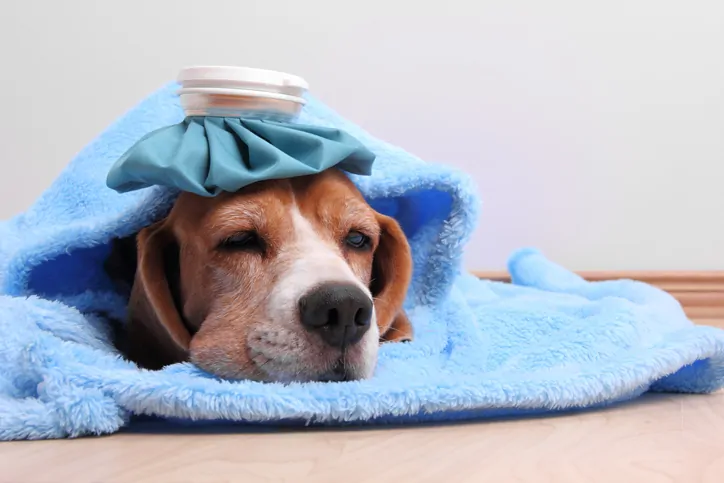
Diarrhea is characterized by the faster transit of feces through the intestines combined with a reduction in the absorption of water, minerals, and electrolytes. When diarrhea is a dog's primary symptom of illness, it may be caused by a very straightforward issue, such as an intestinal infection brought on by bacteria, coccidia, or intestinal worms such as hookworms, roundworms, or whipworms.
A change in diet or dietary misconduct (eating trash or other irritating foods) is a frequent cause of acute diarrhea in dogs. Acute diarrhea can also be brought on by stress, particularly after traveling, boarding, or experiencing other environmental changes. Other causes of diarrhea in dogs include:
When your dog has diarrhea, most of the water they drink is passed through the body instead of absorbed by the intestines. This causes gradual dehydration that can cause electrolyte imbalances and put a strain on the kidneys resulting in organ failure. Seek veterinary care if your pet exhibits the following symptoms:
If diarrhea doesn't resolve within 48 to 72 hours, you should seek veterinary care for your pup.
When you take your dog to the veterinary hospital, the first thing your vet may want to do is diagnose the cause of their diarrhea symptoms. Your vet will test your pup's stool for intestinal parasites, Giardia, and certain kinds of bacteria. Blood might be taken to catch signs of metabolic disease, protein loss, anemia, inflammation, and other conditions. Other tests including CPL tests, radiographs, and ultrasound may be necessary.
Your dog's diarrhea treatment plan is dependent on the results of their tests. Parasites can be treated with dewormer. Bacteria populations may be managed with probiotics. Anti-diarrheal agents and food restrictions may be prescribed to reset your dog's gut. If your dog does not respond to initial treatment within 48 to 72 hours then more tests and new treatments may be needed.
Canine diarrhea resolves on its own in a day or two. In most circumstances, there is no cause for concern because many dogs with diarrhea act and feel fine. A short fast (12 to 24 hours) followed by a bland diet is all that is needed to stop diarrhea in dogs, but, young puppies should not fast. Some home-care remedies for doggy diarrhea are:
Once you find a recovery diet that agrees with your dog, you can increase their portions over the course of a few days. Dogs with uncomplicated diarrhea usually make a full recovery, but those with chronic diarrhea may need long-term medication or nutritional therapy to keep their diarrhea issues under control.
Phone: (855) 461-8259
Email: [email protected]